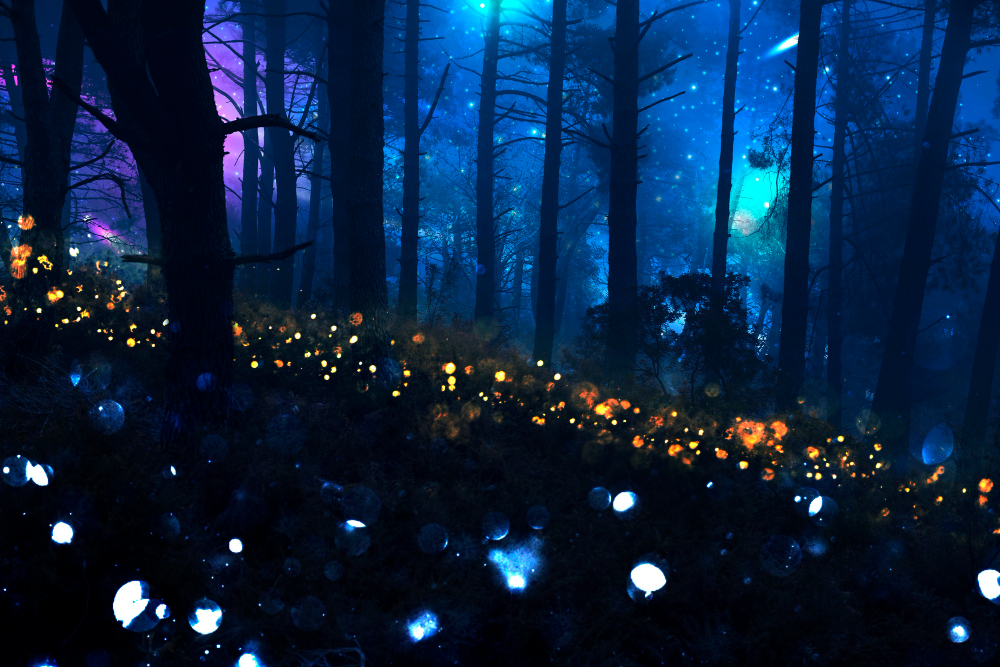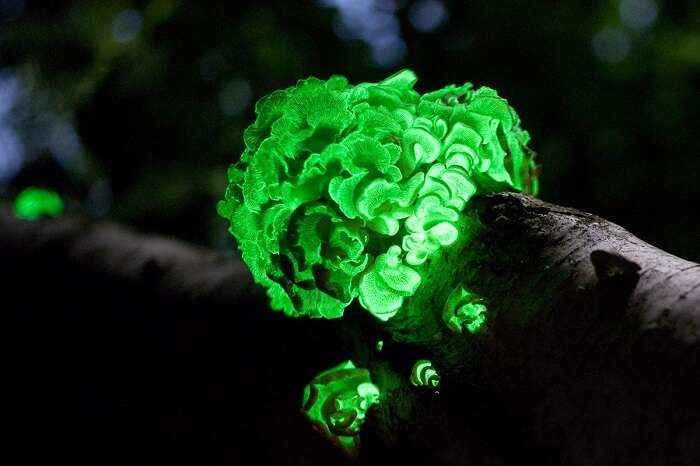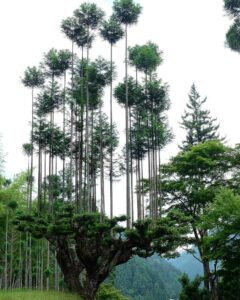In the Western Ghats, nestled between the bustling states of Maharashtra and Goa, lies a secret wonder of nature that scarcely seems real. Nature, in its boundless creativity, has painted a canvas of wonder that needs no special effects to evoke a sense of awe. This marvel is the glowing forests of Bhimashankar Wildlife Sanctuary, a spectacle so surreal that it could easily belong in a fairy tale.

Image by Freepik.com
Table of Contents
A Faint Green Glow Begins

Image by Tripoto
By day, these forests present a facade of normalcy. The lush green canopies, the dense undergrowth, and the vibrant chorus of wildlife create a scene typical of any other forest within the Western Ghats. However, as the sun dips below the horizon, and night engulfs the landscape, a transformation begins, one that has captivated the curiosity and imagination of those fortunate enough to witness it.
Particularly during the monsoon season, when the rain pours down in relentless streams, soaking every leaf, branch, and root in its path, the forest undergoes its enchanting metamorphosis. The phenomenon that follows is as mesmerizing as it is mysterious.
As darkness envelops the forest, a faint green glow begins to emerge, casting a spectral luminescence over the wet foliage. This ethereal glow, reminiscent of scenes from a fantasy novel, is not the product of digital manipulation or optical illusion. It’s a natural wonder, an organic spectacle that draws visitors from across the globe to experience its magic firsthand.
What could be the source of this nocturnal illumination? The answer lies in the unique interplay between the forest’s biology and the nurturing rains of the monsoon. Yet, to uncover the secret behind this natural luminescence, one must delve deeper into the forest’s nocturnal life, exploring its mysteries under the cover of night. Nature, in its timeless artistry, has crafted a spectacle in the glowing forests of the Western Ghats that stands as a testament to the wonders that lie hidden in the natural world, awaiting discovery by those who seek them.
The Mystery of India's Glowing Forests

Image by Tripoto
Among the many marvels that Bhimashankar offers, the phenomenon of glowing forests stands out, captivating the imagination of visitors. These forests exhibit a mystical glow after sunset, a spectacle attributed to bioluminescent fungi that adorn the forest floor and decomposing logs. The primary species responsible for this glow is Mycena, a type of mushroom that emits light through a chemical reaction to attract insects and facilitate spore dispersal.
In the midst of a remote, little-known village called Ahupe, there unfolds a phenomenon so unusual yet breathtakingly beautiful, casting a mystical allure over the dense forest during the monsoon season. This enchanting spectacle is the handiwork of Mycena, a bacteria with properties unlike any other. When the air fills with moisture, a condition frequent in the lush environs of Ahupe, Mycena begins to glow. This luminescent bacteria finds its home on the bark of branches, twigs, and the decaying leaves carpeting the forest floor, creating an ethereal glow that seems to breathe life into the night.
Scientists have labeled this natural magic as bioluminescence, a phenomenon not exclusive to forests but also observed in certain sea creatures. What sets Mycena apart is its mysterious, glowing characteristic, which remains a puzzle to the scientific community. They ponder over why and how these bacteria emit light, a question that adds to the allure of the glowing forest. Despite their extensive research, predicting when the forest will next light up remains beyond their current understanding. Yet, when it does happen, the sight captures the heart and imagination, leaving an indelible impression on anyone fortunate enough to witness it.
Beyond the unique Mycena bacteria, the forests within the same wildlife sanctuary and other regions of the Western Ghats come alive with another source of natural light—fireflies. These tiny insects contribute to the luminescent wonder, especially during the night, weaving in and out of the darkness, their flickering lights syncing in a magical dance. The best way to immerse oneself in this fairy-tale visual is by embarking on a night trek to places like Rajmachi Fort or Bhandardara, where the combined glow of Mycena and the twinkling of fireflies transforms the forest into a scene right out of a fantasy.
This remarkable glow, be it from the peculiar bacteria or the countless fireflies, paints the dark canvas of the night with strokes of light, illuminating the forests with a beauty so surreal, it seems like a dream.
Video: Bhimashankar Wildlife Sanctuary - A Biodiversity Haven
Spanning an area of approximately 120 square kilometers, Bhimashankar is renowned for its rich biodiversity. It is home to the majestic Indian Giant Squirrel, an array of birds, leopards, and a diverse range of plant species, making it a critical conservation area.
Hikers and spiritual seekers are also drawn to the area due to the presence of the Bhimashankar Temple, one of the twelve Jyotirlingas, making it a unique blend of natural beauty and cultural heritage.
Scientific Exploration and Conservation Efforts
The discovery of bioluminescence in Bhimashankar’s forests has piqued the interest of scientists and conservationists, highlighting the need to preserve these magical ecosystems. Research and conservation efforts are underway to understand the ecological roles of bioluminescent fungi and to safeguard the sanctuary’s biodiversity, ensuring that future generations can witness this extraordinary natural phenomenon.
Nature's Luminous Wonders: The Best Times to Witness Bioluminescence and Fireflies
The best time to experience the enchanting phenomenon of bioluminescence is somewhat dependent on nature’s whims, particularly in the monsoon months of July, August, and September. Although it doesn’t occur daily, your chances of witnessing this magical display increase significantly after an evening of heavy rains during these months. In contrast, if you’re eager to catch the mesmerizing dance of fireflies, plan your visit for the pre-monsoon period, specifically in May and June. During these months, spotting fireflies is much easier, allowing you to enjoy one of nature’s most captivating shows.
The Bhimashankar Wildlife Reserve is a testament to the wonders that lie hidden in India’s vast natural landscapes. The mysterious glowing forests serve as a reminder of nature’s endless mysteries and the importance of preserving these natural wonders. As awareness grows and conservation efforts strengthen, Bhimashankar remains not just a sanctuary for wildlife but a beacon of mystical natural beauty, inviting all to explore its wonders responsibly.






























